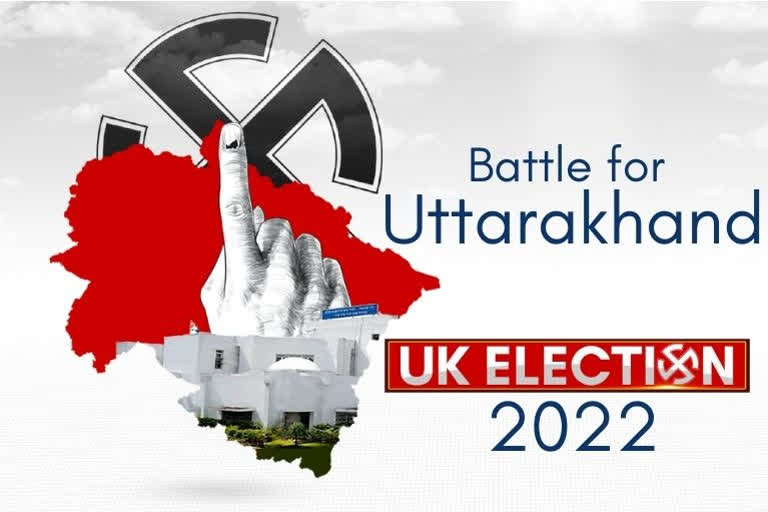Dehradun: Polling in the hill state of Uttarakhand is scheduled in one phase on Monday, February 14, and this time too, the question being asked by everyone in the state is: will the state get a stable government that lasts its full term?
Ever since its formation in November 2000, the state of Uttarakhand has seen ten chief ministers, and only two of them - Narayan Dutt Tiwari of the Congress (from March 2, 2002 to March 7, 2007) and Trivendra Singh Rawat of the Bharatiya Janata Party (from March 18, 2017 to March 9, 2021) had the privilege to complete more than three years in office. In fact, Tiwari was the only Chief Minister to have completed a full term.
The state has so far seen only Congress and BJP remain in power, often in turns. Interestingly, in the case of both parties, the legislators of this 70-member Assembly have shown a restlessness that made stability elusive for the Chief Minister. The question foremost on every resident’s mind is whether the verdict this time will be decisive, or a fractured one as in the past, leading to unstable governments.
READ: Uttarakhand Polls: Nobody in Congress has objections to me as CM face, says Harish Rawat
In the 2017 election, the BJP had won 57 seats, which was a decisive victory, and Trivendra Rawat’s nomination as Chief Minister was generally welcomed. However, he quit before he could complete four years in office as legislators’ resentment against him grew on various counts and the BJP leadership sensed that his continuation could lead to defections and subsequent loss of majority. His successor Tirath Singh Rawat proved to be a stopgap arrangement and he too resigned in less than four months. The present Chief Minister, Pushkar Singh Dhami, was a surprise choice when he took office on July 4, 2021. The frequent and unseemly change in leadership has been a sore point in the state’s political history.
Distinct identity
The state has two divisions of Garhwal and Kumaon, and the residents of the two regions are proud of their distinct identity, so much so that disagreement on almost anything is common among residents of the two regions. Despite the fact that religious pilgrimage and tourism are the mainstays of the state’s economy, political stability has stemmed from these and other issues of regional disparity.
In December, some participants allegedly gave inflammatory speeches at a dharam sansad (religious congregation) held in Haridwar and it was expected that it will become a major factor in the election and also could go in the favour of the Congress. It is interesting to note that the issue did not find mention in the election campaign. Both the Congress and the new entrant to state politics, the Aam Aadmi party (AAP) have avoided making dharam sansad a major issue.
Among the issues raised in the campaigning by Congress and AAP are corruption, employment generation, education, health infrastructure and pollution. Delay and irregularities in several projects related to tourism and environmental protection of the fragile ecosystem of the hills are also major issues. Prime Minister Narendra Modi has toured the state, invoking hill pride with the name of late General Bipin Rawat. AAP leader Arvind Kejriwal in his campaigning had suggested that the state was fed up with instability under both Congress and BJP, and AAP could change the face of the state with sops like monthly allowances of Rs 1,000 to all women, Rs 5,000 to all unemployed youths and creation of 1 lakh jobs.
Unlike Uttar Pradesh – from which state Uttarakhand was carved in 2000 – social engineering is not a major political exercise in this hill state. The Muslim population is low and confined to some districts only. Less than 20 per cent population is Dalit, and the state is a major religious destination for Hindus all over the world. Religious polarisation, therefore, seems irrelevant in elections. Caste identities also played little role in past elections. The Bahujan Samaj Party (BSP) has tied its hand in looking for support among the Dalit population but has not succeeded much.
With both the Congress and the BJP walking the same path, using the same tactics and indulging in similar kinds of politics, both parties have been witnessing similar infighting, rebellion, and lack of decisive leadership. As for Dhami, his youthful approach and ability to handle dissatisfaction among his legislators has been welcomed in the BJP, and it is expected that in case of a win, he could be made the Chief Minister again. While veteran Congress leader Harish Rawat would have liked his name to be announced as the party’s chief minister face, it did not happen, even though he remains one of the few leaders with some sort of acceptance in both regions.
Disclaimer: The opinions expressed in this article are that of the writer. The facts and opinions expressed here do not reflect the views of ETV Bharat.



